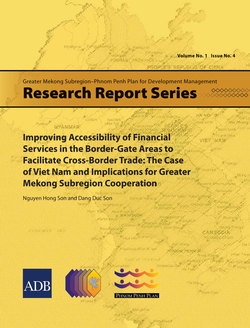Читать книгу Improving Accessibility of Financial Services in the Border-Gate Areas to Facilitate Cross-Border Trade - Nguyen Hong Son - Страница 7
1. Introduction
ОглавлениеSince the early 2000s, cross-border trade has expanded rapidly among the countries in the Greater Mekong Subregion (GMS). Among other factors, the increase in cross-border trade has been stimulated by the application of a number of trade facilitation measures.
Facilitating cross-border trade is one of the five strategic thrusts of the 10-year Strategic Framework for the GMS Program that was endorsed in 2002 by the First GMS Summit. Its blueprint for action was set in the Strategic Framework for Action on Trade Facilitation and Investment which was approved by the Second GMS Summit in 2005. To support transport and trade facilitation, the GMS countries have also implemented since 1999 the Cross-Border Transport Agreement. Nevertheless, the important role of financial services as a cross-border trade facilitation factor has been so far overlooked in GMS cooperation. Although the strategic framework does not exclude financial services, at present it emphasizes customs procedures, inspection and quarantine measures, trade logistics, and mobility of business people as the four priority cross-border trade facilitating measures. Similarly, other trade facilitation measures, such as those incorporated in the Cross-Border Transport Agreement, have dealt merely with such border-crossing formalities and procedures as single-window and single-stop customs inspection; facilitation of the movement of goods, people and vehicles; and phytosanitary and veterinary inspection, and they have ignored the financial aspects of cross-border trade.
Inaccessibility is a major constraint to the use of financial services in the border areas of the GMS. The slow rate of expansion of financial services in the border-gate areas is out of step with the rapid growth of cross-border trade in the GMS. The dynamic border economy provides major opportunities for the growth of financial services in these areas, but banks are slow to tap this potential. As of 2010, only a few bank branches are established in the border areas, and only a small proportion of border trade in the GMS is financed through the commercial banks; the rest is through barter or cash. For example, settlement through banks accounts for a mere10% of the total cross-border trade volume between Viet Nam and the People’s Republic of China (PRC). In 2008, the value of trade between Viet Nam and Cambodia was $1.7 billion ($1.0 billion was the border trade value) and only $7.0 million (0.4%) of the cash was deposited into bank accounts by traders (Ministry of Industries and Trade [MOIT] 2009).
Even where banks are present in the border-gate areas, their services are still inaccessible to a large number of businesses. Banking services often stipulate restrictive criteria (e.g., a minimum deposit and evidence of good credit history) that disqualify small and informal businesses. The excessive paper work and high fees make getting a loan cumbersome and too costly for many borrowers seeking only small amounts. Banks may demand collateral, and pose other nonpecuniary challenges, such as requiring greater literacy, which poor borrowers lack (Claessens 2005: 12). Moreover, bank offices may have inconvenient location at the border gate or unsuitable working hours. The capability of banks to provide services needed by local businesses may also be limited. As a result, individuals, households, and firms have to rely on informal financial services, which appear to be a viable option in the less developed border areas.
In the most important border-gate areas of the GMS (e.g., Moc Bai, Bavet, Lao Bao, Densavan, Mong Cai, Dongxing, Lao Cai, and Hekou), there are black market currency exchange points with hundreds of money changers eagerly searching for clients. Compared to the banks, these informal financial service providers are more flexible with regard to customers’ needs and offer faster service. Nevertheless, informal services may be unreliable because they bear a high risk (e.g., exchange rate volatility, default, or transaction error), and easily become facilitators of illegal activities (e.g., tax evasion or money laundering). In addition, customers of informal services are easily subjected by service providers to unsympathetic behaviors, such as abuse and harassment. For most cross-border traders in the GMS, default on payment constitutes a big risk in the absence of payment guarantee services from banks (Nguyen and Cu 2005). Although informal financial services have an advantage in terms of number of providers and flexibility of conditions, concerns about reliability, assurance, and empathy may adversely affect customers’ decisions to use their services in the border-gate areas.
Inadequate policy attention to financial service development does not mean that there is little demand for financial services in the border-gate areas. Rather, it may reveal the mismatch between policy priorities and the needs of the local business community and residents. Using the case study of Viet Nam to draw implications for GMS cooperation, this paper investigates how users and providers of financial services in the border-gate areas see financial services as a factor of cross-border trade facilitation. It also examines how users and providers of financial services evaluate different dimensions of financial service accessibility and how these dimensions of accessibility affect customers’ decisions to use financial services in the border-gate areas.
